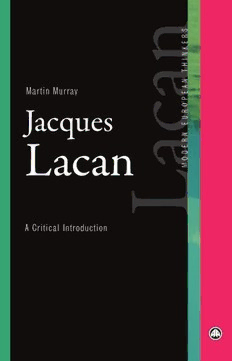Table Of ContentJacques Lacan
Modern European Thinkers
Series Editors: Anne Beech and David Castle
Over the past few decades, Anglo-American social science and humanities have
experienced an unprecedented interrogation, revision and strengthening of their
methodologies and theoretical underpinnings through the influence of highly
innovative scholarship from continental Europe. In the fields of philosophy,
post-structuralism, psychoanalysis, critical theory and beyond, the works of
a succession of pioneering writers have had revolutionary effects on Anglo-
American academia. However, much of this work is extremely challenging, and
some is hard or impossible to obtain in English translation. This series provides
clear and concise introductions to the ideas and work of key European thinkers.
As well as being comprehensive, accessible introductory texts, the titles in the
Modern European Thinkers series retain Pluto’s characteristic radical political
slant, and critically evaluate leading theorists in terms of their contribution to
genuinely radical and progressive intellectual endeavour. And while the series does
explore the leading lights, it also looks beyond the big names that have dominated
theoretical debates to highlight the contribution of extremely important but less
well-known figures.
Also available:
Hannah Arendt André Gorz
Finn Bowring Conrad Lodziak and Jeremy Tatman
Alain Badiou Félix Guattari
Jason Barker Gary Genosko
Georges Bataille Jürgen Habermas
Benjamin Noys Luke Goode
Jean Baudrillard Bruno Latour
Mike Gane Graham Harman
Walter Benjamin Herbert Marcuse
Esther Leslie Malcolm Miles
Pierre Bourdieu Guy Hocquenghem
Jeremy F. Lane Bill Marshall
Gilles Deleuze Slavoj Zˇiˇzek
John Marks Ian Parker
Jacques Lacan
A Critical Introduction
Martin Murray
First published 2016 by Pluto Press
345 Archway Road, London N6 5AA
www.plutobooks.com
Copyright © Martin Murray 2016
The right of Martin Murray to be identified as the author of this work has been
asserted by him in accordance with the Copyright, Designs and Patents Act 1988.
British Library Cataloguing in Publication Data
A catalogue record for this book is available from the British Library
ISBN 978 0 7453 1595 9 Hardback
ISBN 978 0 7453 1590 4 Paperback
ISBN 978 1 7837 1723 1 PDF eBook
ISBN 978 1 7837 1725 5 Kindle eBook
ISBN 978 1 7837 1724 8 EPUB eBook
This book is printed on paper suitable for recycling and made from fully
managed and sustained forest sources. Logging, pulping and manufacturing
processes are expected to conform to the environmental standards of the
country of origin.
Typeset by Stanford DTP Services, Northampton, England
Text design by Melanie Patrick
Simultaneously printed in the European Union and United States of America
Contents
Acknowledgements viii
1 Stopping and Starting 1
2 Sweet and Sour 7
3 Sense and Nonsense 29
4 Man and Window 36
5 I and I 73
6 Fight and Flight 126
7 Word and Wish 157
8 Ending and Beginning 186
Notes 189
Bibliography of Works by Lacan 200
General Bibliography 202
Index 206
I always speak the truth. Not the whole truth, because there’s no way to
say it all.
Lacan
I believe that truth has only one face: that of a violent contradiction.
Bataille
Acknowledgements
I would like to thank the following people who, in one way or another, have
helped me write this text: Sara Barrett, Emma Bell, Geoffrey Bennington,
Rachel Bowlby, Carolyn Burdett, Scott Davidson, Mark Dubois, John
Dudley, Merl Fluin, Roddy Gallacher, Jim Grant, Claire Hodgson, Anne
Hogan, Martin Jenkins, Angela Joyce, Valli Kohon, Vicky Lebeau, Michael
Morris, Kathryn Murray, Sheila Murray, Sue Pike, Inge Pretorius, Rena
Proud, Jacqueline Rose, Viqui Rosenberg, Kate Soper, Barry Stocker,
Jenny Stoker, Gillian Tunstall, Will Viney, Wendy Wheeler, Peter Wilson,
Andrew Wright, Jessica Yakeley and Marie Zaphirou-Woods. Special thanks
are extended to five people who have been particularly generous with their
time, advice, ideas and support, namely Anne Beech, Sira Dermen, Mary
Fitzgerald, David Hansen-Miller and Bill Murray. Finally, this book is for
the two people who have, during its writing, most engaged with me in
the matter which psychoanalysis is primarily or significantly about, namely
love. It is therefore dedicated to Teresa Fitzgerald and Miles Murray.
1
Stopping and Starting
About
This book is ‘about’ Jacques Lacan. Perhaps this is obvious or straightfor-
ward. Yet the fact that the word ‘about’ is included in the first sentence
of this introduction in inverted commas (or ‘scare quotes’) indicates
something else. It indicates that what Lacan was ‘about’ isn’t obvious and
that showing and addressing this might not be straightforward.
Thus the inverted commas indicate a problem. Yet they also indicate a
solution to that problem. Both the problem and the solution are outlined
below.
Here is the problem: it is difficult to say (because it is difficult to know)
what Lacan was ‘about’. This is most obviously true of his pronounce-
ments: his essays, papers, talks, seminars and books. He spoke or wrote in
riddles. Quite often, he contradicted himself. It’s a challenge to write about
him clearly, simply and accurately because it’s difficult to understand what
he meant. To make things worse, he didn’t want to be understood – at
least some of the time. For various reasons, it is hard to know what he was
‘about’ intellectually.
Lacan was also personally difficult. He sometimes seemed mad or
even pernicious and he often seemed obscure. Yet this didn’t seem to
bother him. Indeed, his eccentric behaviour seemed willed. It’s thus hard
to discern what his intentions were. Why did he act as he did? These
questions indicate another reason for the inverted commas around the
word ‘about’ above. The question ‘what was Lacan ‘about?’ doesn’t just
mean ‘what did his ideas mean?’ It also means: ‘what was he up to?’
Thus in trying to discern what Lacan was ‘about’ one has to grapple
both with what he said and meant and with what he did and why he did
it. How might one begin to do this? There is a way; in fact there is more
than one way.

